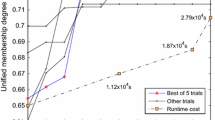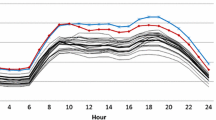Abstract
Low cost, high reliability and low pollution are prime targets when performing current unit commitment optimization. As an extension of previous works, this study establishes a multi-objective unit commitment model which takes into account all of the above targets. The main content includes: First, the pricing support for thermal units with ultra-low emissions is involved when analyzing the operation cost of generation systems, which accords with the current policy of power markets. Second, a conditional Value-at-Risk-based measurement is formed to estimate system reliability considering the stochastic and fuzzy uncertainties existed in future load, renewable generation and equipment failures, which is sensitive to tail risks and provides easy-to-adjust conservativeness against worst-case scenarios. Third, to deal with the proposed model, a practical approach is applied to develop a multi-objective particle swarm optimization algorithm, which improves the Pareto fronts obtained by existing methods. The effectiveness of this research is exemplified by two case studies, which demonstrate that the model finds appropriate pricing support for the reformed units, and the proposed reliability measurement is able to realize a number of trade-offs between cost effective and solution robustness, thus providing decision support for system operators. Finally, the comparisons on performance metrics such as spacing and hyper-volume also justify the superiority of the algorithm.









Similar content being viewed by others
References
Wang Z, Zhang L, Li G, Yang L (2018) Active power and reactive power dispatch of wind farm based on wavelet learning. Int J Mach Learn Cybern 9(2):217–223
Zhao Y, Xing W, Lu W, Zhang X, Christensen TH (2012) Environmental impact assessment of the incineration of municipal solid waste with auxiliary coal in China. Waste Manag 32(10):1989–1998
Zheng QP, Wang J, Liu AL (2015) Stochastic optimization for unit commitment-a review. IEEE Trans Power Syst 30(4):1913–1924
Gooi H, Mendes D, Bell KRW, Kirschen D (1999) Optimal scheduling of spinning reserve. IEEE Trans Power Syst 14(4):1485–1492
Wang S, Pedrycz W (2015) Robust granular optimization: a structured approach for optimization under integrated uncertainty. IEEE Trans Fuzzy Syst 23(5):1372–1386
Duffie D, Pan J (1997) An overview of value-at-risk. J Deriv 4(3):7–49
Wang B, Wang S, Watada J (2011) Fuzzy portfolio selection models with Value-at-Risk. IEEE Trans Fuzzy Syst 19(4):758–769
Ma W, Cheng R, Ke H, Zhao Z (2019) Optimal pricing decision for supply chains with risk sensitivity and human estimation. Int J Mach Learn Cybern 10(7):1717–1730
Wang B, Wang S, Zhou X, Watada J (2016) Two-stage multi-objective unit commitment optimization under hybrid uncertainties. IEEE Trans Power Syst 31(3):2266–2277
Alexander GJ, Baptista AM (2004) A comparison of VaR and CVaR constraints on portfolio selection with the mean-variance Model. Manag Sci 50(9):1261–1273
Uryasev SP (2000) Probabilistic constrained optimization methodology and applications. Kluwer, Dordrecht
Rahimi M, Ghezavati V (2018) Sustainable multi-period reverse logistics network design and planning under uncertainty utilizing conditional value at risk (cvar) for recycling construction and demolition waste. J Clean Prod 172:1567–1581
Asensio M, Contreras J (2015) Stochastic unit commitment in isolated systems with renewable penetration under CVaR assessment. IEEE Trans Smart Grid 172:1567–1581
Wang B, Wang SM, Zhou X, Watada J (2016) Multi-objective unit commitment with wind penetration and emission concerns under stochastic and fuzzy uncertainties. Energy 111(1):18–31
Xu Z, He Y, Wang X (2019) An overview of probabilistic-based expressions for qualitative decision-making: techniques, comparisons and developments. Int J Mach Learn Cybern 10(6):1513–1528
Chen R, Guo S, Wang X, Zhang T (2019) Fusion of multi-RSMOTE with fuzzy integral to classify bug reports with an imbalanced distribution. IEEE Trans Fuzzy Syst 27(12):2406–2420
Li H, Zhang L, Zhou X, Huang B (2017) Cost-sensitive sequential three-way decision modeling using a deep neural network. Int J Approx Reason 85(4):68–78
Li J, Yang X, Song X, Li J, Wang P, Yu D (2019) Neighborhood attribute reduction: a multi-criterion approach. Int J Mach Learn Cybern 10(4):731–742
Niu J, Huang C, Li J, Fan M (2018) Parallel computing techniques for concept-cognitive learning based on granular computing. Int J Mach Learn Cybern 9(11):1785–1805
Yang ZK, Liu P, Cheng L, Wang H, Ming B, Gong WT (2018) Deriving operating rules for a large-scale hydro-photovoltaic power system using implicit stochastic optimization. J Clean Prod 195:562–572
Coello C, Pulido G, Lechuga M (2004) Handling multiple objectives with particle swarm optimization. IEEE Trans Evolut Comput 8(3):256–279
Srinivas N, Deb K (1995) Multiobjective function optimization using nondominated sorting genetic algorithms. Evolut Comput 2(3):221–248
Deb K, Pratap A, Agarwal S, Meyarivan T (2002) A fast and elitist multi-objective genetic algorithm: NSGA-II. IEEE Trans Evolut Comput 6(2):182–197
Tripathi P, Bandyopadhyay S, Pal S (2007) Multi-objective particle swarm optimization with time variant inertia and acceleration coefficients. Inf Sci 177(22):5033–5049
Wang B, Li Y, Watada J (2013) Supply reliability and generation cost analysis due to load forecast uncertainty in unit commitment problems. IEEE Trans Power Syst 28(3):2242–2252
Zitzler E, Deb K, Thiele L (2000) Comparison of multiobjective evolutionary algorithms: empirical results. Evolut Comput 8(2):173–195
Kim JO, Singh C (2002) Including uncertainty in LOLE calculation using fuzzy set theory. IEEE Trans Power Syst 17(1):19–25
Liu B, Liu YK (2002) Expected value of fuzzy variable and fuzzy expected value models. IEEE Trans Fuzzy Syst 10(4):445–450
Wang SM, Wang B, Watada J (2017) Adaptive budget-portfolio investment optimization under risk tolerance ambiguity. IEEE Trans Fuzzy Syst 25(2):363–376
Chen K, Chen K, Wang Q, He Z, Hu J, He J (2019) Short-term load forecasting with deep residual networks. IEEE Trans Smart Grid 10(4):3943–3952
Wan C, Xu Z, Pinson P, Dong ZY, Wong KP (2014) Probabilistic forecasting of wind power generation using extreme learning machine. IEEE Trans Power Syst 29(3):1033–1044
Hong T, Wilson J, Xie J (2014) Long term probabilistic load forecasting and normalization with hourly information. IEEE Trans Smart Grid 5(1):456–462
Wang B, Zhou M, Watada J (2017) Unit commitment optimization with pricing support for ultra-low emissions: a multi-objective approach. In: Proceedings of the 3rd IEEE international conference on control science and systems engineering, pp 692–697
Wang SJ, Shahidehpour SM, Kirschen DS, Mokhtari S, Irisarri GD (1995) Short-term generation scheduling with transmission and environmental constraints using an augmented Lagrangian relaxation. IEEE Trans Power Syst 10(3):1294–1301
Trivedi A, Srinivasan D, Sharma D, Singh C (2013) Evolutionary multi-objective day-ahead thermal generation scheduling in uncertain environment. IEEE Trans Power Syst 28(2):1345–1354
Chang PT, Hung KC (2006) \(\alpha\)-cut fuzzy arithmetic: simplifying rules and a fuzzy function optimization with a decision variable. IEEE Trans Fuzzy Syst 14(4):496–510
Reddy SS (2019) Optimal power flow using hybrid differential evolution and harmony search algorithm. Int J Mach Learn Cybern 10(5):1077–1091
Kennedy J, Eberhart R (1995) Particle swarm optimization. In: Proceedings of the 1995 IEEE international conference on neual networks, IV, pp 1942–1948
Lee J, Kim J, Song J, Kim Y, Jung S (2016) A novel memetic algorithm using modified particle swarm optimization and mesh adaptive direct search for PMSM design. IEEE Trans MAGN 52(3):1–4
Lin C, Li M, Ting A, Lin M (2011) A robust self-learning PID control system design for nonlinear systems using a particle swarm optimization algorithm. Int J Mach Learn Cybern 2(4):225–234
Liu J, Li H, Huang B, Zhou X, Zhang L (2019) Similarity-divergence intuitionistic fuzzy decision using particle swarm optimization. Appl Soft Comput 81:1–18
Behera SR, Panigrahi BK (2019) A multi objective approach for placement of multiple DGs in the radial distribution system. Int J Mach Learn Cybern 10(8):2027–2041
Simopoulos DN, Kavatza SD, Vournas CD (2006) Reliability constrained unit commitment using simulated annealing. IEEE Trans Power Syst 21(4):1699–1706
Yang Y, Wu K, Long H, Gao J, Yan X, Kato T, Suzuoki Y (2014) Integrated electricity and heating demand-side management for wind power integration in China. Energy 78:235–246
Clerc M (2006) Particle swarm optimization. ISTE, London
Wang H, Jiao L, Yao X (2015) \(\text{ Two }\_\text{ Arch2 }\): an improved two-archive algorithm for many-objective optimization. IEEE Trans Evolut Comput 19(4):524–541
Rada-Vilela J, Chica M, Cordon O, Damas S (2013) A comparative study of multi-objective ant colony optimization algorithms for the time and space assembly line balancing problem. Appl Soft Comput 13(11):4370–4382
Acknowledgements
This work was supported by the National Natural Science Foundation of China (Grant Nos. 61603176, 71732003), the Natural Science Foundation of Jiangsu Province (Grant No. BK20160632), the Young Scholar Support Programme of Nanjing University of Finance&Economics (Grant No. L_YXW15101), and the Fundamental Research Funds for the Central Universities (Grant No. 14380037).
Author information
Authors and Affiliations
Corresponding author
Additional information
Publisher's Note
Springer Nature remains neutral with regard to jurisdictional claims in published maps and institutional affiliations.
Rights and permissions
About this article
Cite this article
Li, Y., Li, H., Wang, B. et al. Multi-objective unit commitment optimization with ultra-low emissions under stochastic and fuzzy uncertainties. Int. J. Mach. Learn. & Cyber. 12, 1–15 (2021). https://doi.org/10.1007/s13042-020-01103-9
Received:
Accepted:
Published:
Issue Date:
DOI: https://doi.org/10.1007/s13042-020-01103-9




